This post may contain affiliate links. Please see our disclosure policy for more details.
Here’s everything you need to know to feed your 8 to 9 month old baby, including how much milk and solid food to offer as well as best foods.
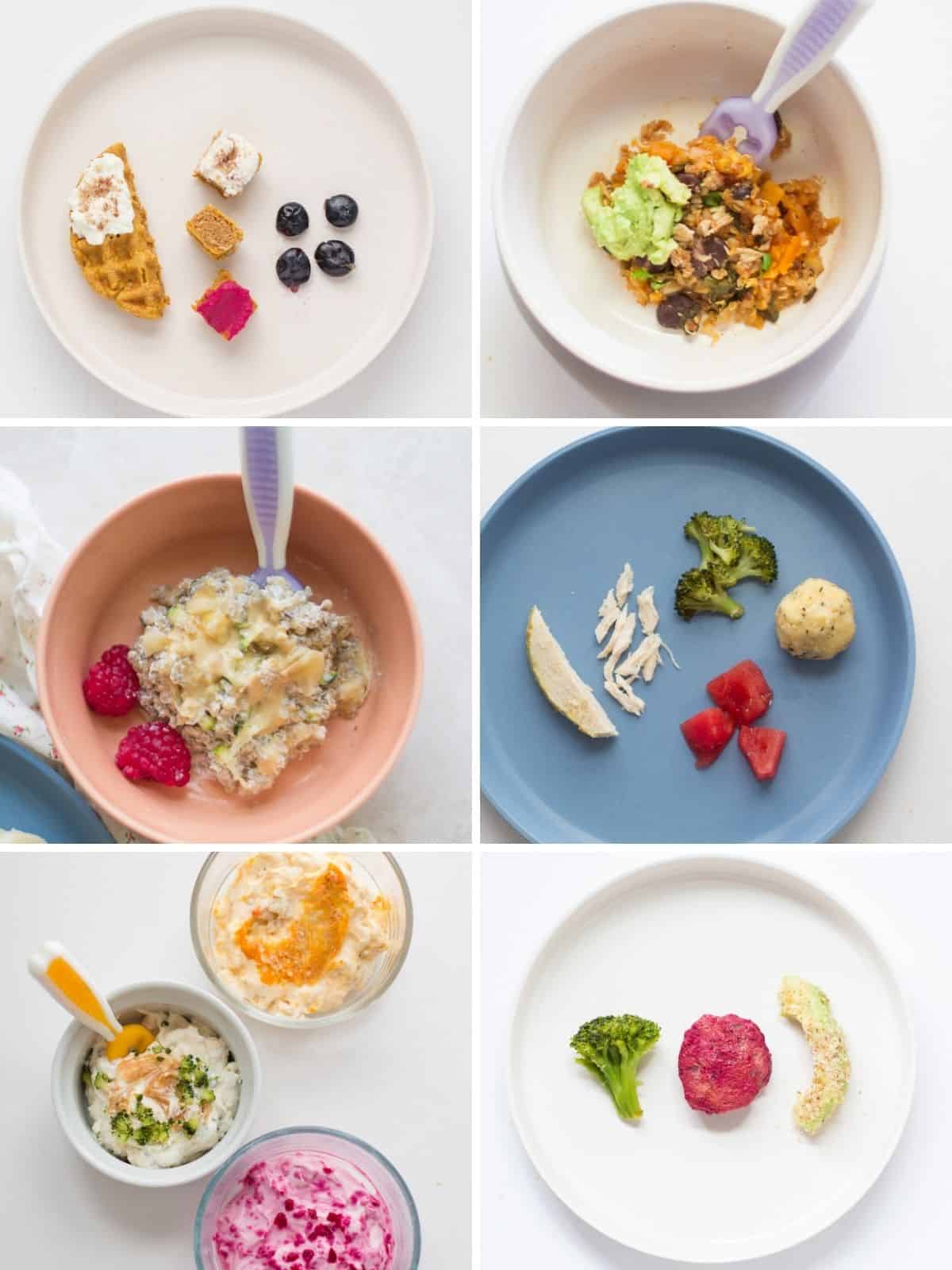
There are three methods of starting solids. You may have exclusively served purees, chosen to do finger foods baby led weaning style, or taken the combination approach.
Regardless of which feeding method you chose, by 8 months, 9 months at the latest, your baby’s meals should look like what I’m about to share.
So let’s dive in!
Table of Contents
Frequently Asked Questions
By eight months, your baby should be eating at least two meals a day. Some suggest three meals at this age, but again, every baby is different! There’s no need to force your baby to eat 3 meals a day when they’re simply not interested or hungry for it.
Two meals are plenty! You will also save yourself a lot of frustration by following your baby’s cues.
Some even suggest serving three meals and a snack. I want to reassure you that your baby does NOT need a snack until closer to 1 year of age. And even then, your baby may not be interested. Did I just hear a sigh of relief?
What’s more important than making sure your baby gets x amount of food is you creating a positive and relaxing mealtime experience for your baby.
If you are frantically trying to get food on the table and not able to enjoy sharing a meal alongside your baby, they will absolutely sense that, which can negatively affect their ability to eat.
Both of my babies weren’t ready for 3 meals until around 9 months, my son even later because he was born prematurely. But they did great with those 2 meals. And I enjoyed not having to prepare yet another meal for a little while longer ;).
I encourage you to always have your baby join you at the table so you will know when they’re ready for that last meal. If they start smacking and reaching for your food, they’re most likely ready.
I know that was a long answer, but to state simply, your baby should be eating at least 2 meals a day, working towards 3 meals by 9-10 months.
Milk, whether it’s breast milk or formula, is and will continue to be the most important part of your child’s diet up until they turn one.
At this age, daily milk intake should be around 25-32 ounces and if you are nursing, about 4-6 times a day. But keep in mind, every baby is unique. The best thing you can do is use these recommendations as a guide, but follow your baby’s lead first and foremost.
It becomes a bit more challenging to do so when giving milk in a bottle because you can see exactly how much your baby drinks. It’s so easy to get caught up with the numbers. If your baby is turning away, don’t force them to finish the bottle.
Trust their innate ability to self-regulate. Just like how you eat different amounts of food each day, it’s NORMAL for your baby to drink different amounts at each feeding.
Your baby may start to drink less as they begin eating more solid food, and that’s to be expected. Weaning is a gradual process. Continue to offer milk before meals and stay in tune with your baby’s cues.
The American Academy of Pediatrics recommends that your baby consume between 750 and 900 calories each day, of which about 400-500 should come from breastmilk or formula.
Now I don’t know about you, but as someone who struggled with an eating disorder for a long time, I don’t want to count calories, not even for my baby. Also, it totally goes against the baby led approach, which is to TRUST and follow your baby’s innate ability to self regulate.
Just because you offer x amount of food, doesn’t mean your baby is going to eat it all. And neither should you force them to clean their plate. At this stage, it’s still about discovery and learning about what food feels, smells, and tastes like.
Helping them develop a healthy relationship with food starts now! And our feeding practices matter. A LOT. What’s even more important than the food you serve and how much gets eaten is a positive mealtime experience. Help your child stay positive and curious.
So the main takeaway is to prioritize milk feedings and consistently offer well-balanced meals that will help meet their nutritional needs. More on this below!
If your baby is growing, following their unique growth curve, and happy, they are eating the amount of food that’s RIGHT for them, even if it’s less or more than the recommendations or what you think they need to be eating.
While water may be introduced to 6 month olds and older, it is not necessary. Breastmilk or formula will be enough to meet their hydration needs. As long as your baby is having regular wet diapers, there’s no need to worry.
However, you may want to offer sips of water (no more than 2-3 ounces/day so it doesn’t displace milk) to help them practice cup drinking and to get used to the flavor of water.
Drinking from a cup is a lifelong skill, and by introducing early, it will give them plenty of time to explore and practice. Yes, it’s going to be messy but will be well worth it when it comes time to transition your baby from the breast or bottle.
By then your baby will have the skills to drink independently and will easily be able to make the shift.
Keep in mind the goal at this stage is not to get them to drink a large amount of water. It is practice practice!
Feeding Schedule
I want to start off by saying that having a schedule doesn’t mean you have to be super rigid with it. There’s always room for flexibility.
Babies thrive on predictability and routine, and it can also help you to plan your day accordingly.
In terms of when you should offer your baby their meals, it’s really up to you! For us, mornings are hectic, not to mention baby drank a lot of milk upon waking, so we started with lunch, then dinner, and added breakfast last.
Even though we are mainly talking about food, let’s not forget that sleep is a very important piece to all of this. A well-rested baby means a happier baby who will be more interested in exploring the world of food.
I’m sharing our schedule to give you an idea of how to fit in two meals along with milk and nap times. You will notice this pattern – eat, play, sleep.
- 7 am – wake up and milk
- 9-10:15 am – Nap 1
- 10:20 am – Milk
- 11 am – Meal #1
- 12:30-1:30pm – Nap 2
- 1:35 pm – Milk
- 3:30-4:30 pm – Nap 3
- 4:35 pm – Milk
- 6 pm – Meal #2
- 6:30 pm – Milk
- 7 pm – bedtime
How to build a well-balanced plate

How to Cook the Softest Scrambled Eggs for Baby
What does a well-balanced plate look like in practice? With so many food choices, serving meals that will help meet your child’s nutrient needs can feel overwhelming. Please allow me to simplify and make this goal achievable and fun.
- Offer one high-iron food at each meal
- Offer one high-energy food at each meal
- Fruits/vegetables
I want to elaborate a little bit on high-energy foods. Think carbohydrates and fats. Some examples include nuts and seeds, avocado, full fat yogurt, grains, bread, etc.
Fat is an essential nutrient at this age for optimal brain development and growth. And these calorically dense foods are a great way to make every bite count.
You’ll notice that some of the foods overlap. For instance, avocado is a fruit but it’s also a high-energy food or beans are a good source of iron but also a vegetable. Simply decide which category you want the food to count as and fill in the rest.
In terms of the amount, start with small portions to make it less overwhelming for your baby. This will also reduce food waste. You can always offer more if they seem interested.
Real Life Examples

Here are some meals I served to my baby.
- Tofu Veggie Scramble Oatmeal Balls
- Quinoa (iron) with avocado (high-energy), purple cauliflower (vegetable)
- Beef Stroganoff
- Turkey beet meatballs (iron), Avocado rolled in flax seeds (high-energy), Broccoli (vegetable)
Tips for Graduating from Purees
Regardless of which feeding method you chose, the goal is that by 9 months, at the latest, your baby is being introduced to a wide variety of flavors and textures from all food groups.
That’s because research shows that infants who are introduced to textures by 9 months generally have less feeding problems and greater food acceptance down the road.
If you’ve been spoon feeding, start by preloading the spoon and allowing them to pick it up themselves. There may be great resistance at first, and your baby may want you to continue feeding them. But stand strong.
Your baby will eventually realize that mommy or daddy won’t feed them no matter what and begin to explore for themselves.
Also, it’s completely normal for your baby to start eating less during this transition. Managing textured foods is a whole new experience, and your baby will need some extra time to learn the skills to handle them.
And they will when given plenty of opportunities to do so. Therefore, don’t fall back on purees. Keep marching forward. In the meantime, you can increase the amount of milk feeds.
For more tips, here’s an in-depth post on how to transition from purees to table foods.
Best Baby Foods for 8-9 Months
By this age, your baby is working on developing their pincer grasp, which involves using the thumb and the index finger to pick up small pieces of food. You can start serving bite-sized pieces to help practice this new skill.
But do continue offering big pieces of food to minimize frustration and to allow for practice with taking bites.
Iron-rich foods
I’ve dedicated a whole post to this along with recipes! I believe you will find it extremely helpful.
Best iron-rich foods for babies
High-energy foods
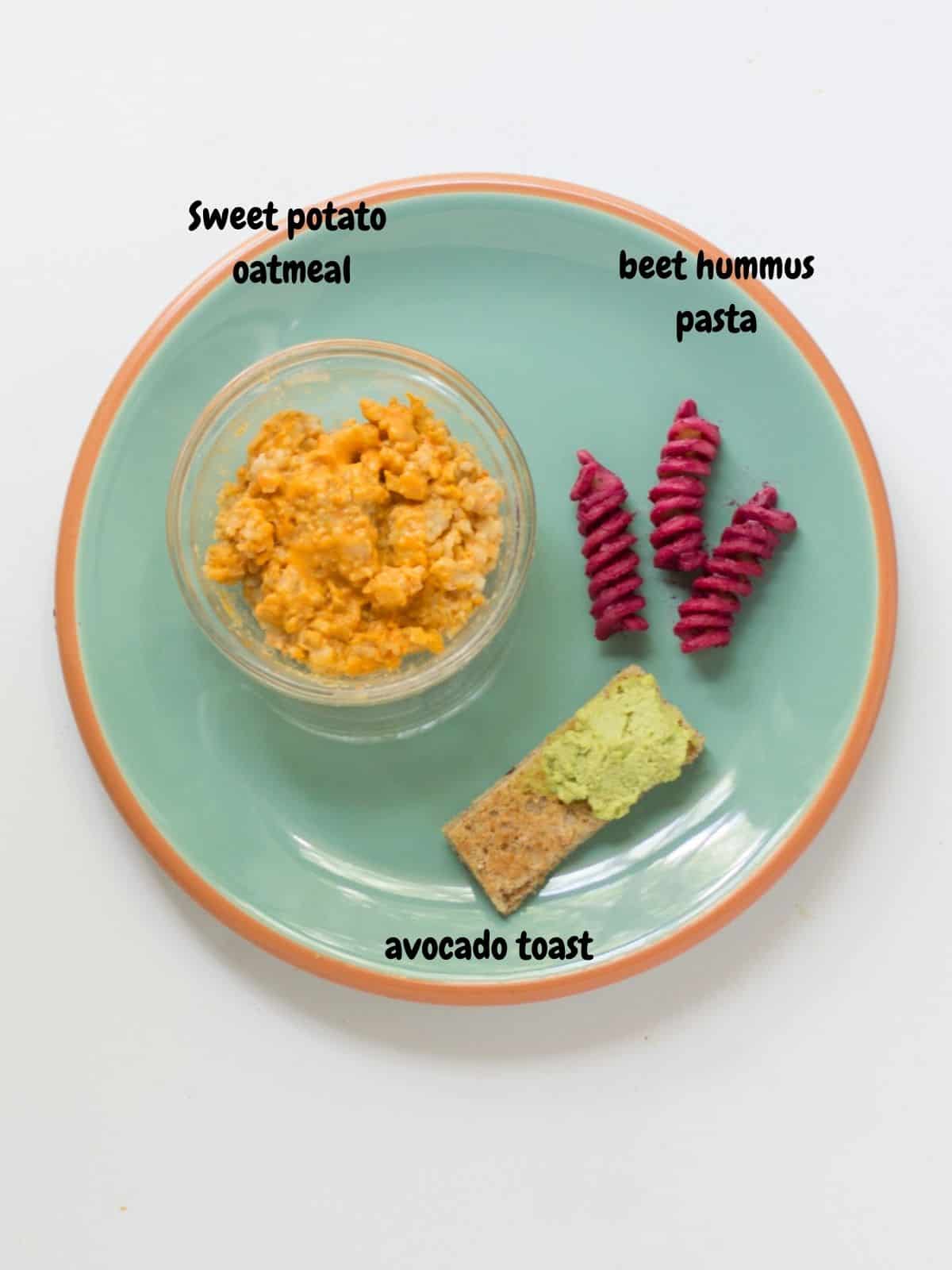
- Avocado
- Oatmeal
- Nuts and Seeds
- Lentils
- Quinoa
- Yogurt
- Bread
- Pasta
- Muffins
- Dips/Sauces
- Waffles
- Pancakes
Best Weight Gain Foods for Babies
Fruits and Vegetables
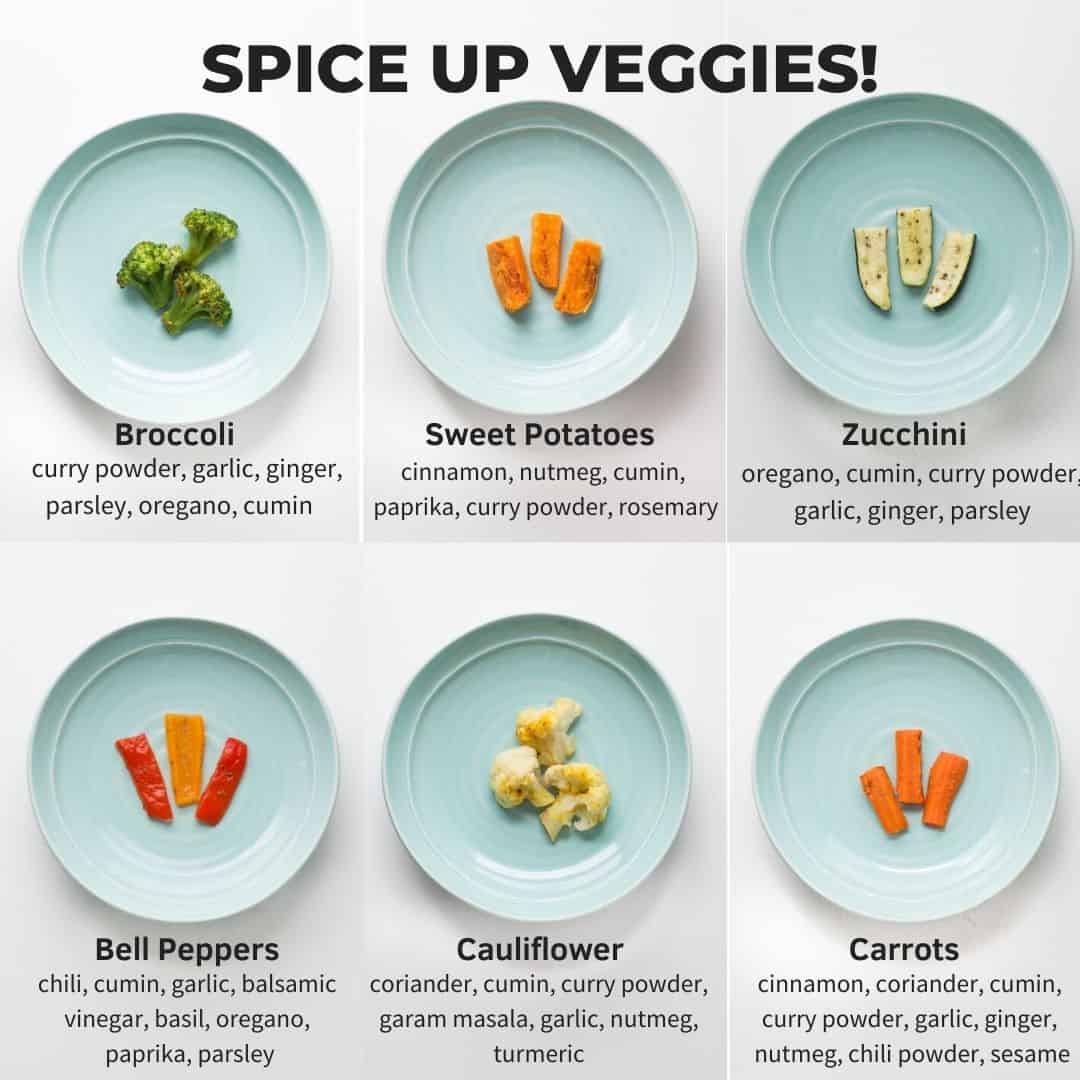
- Butternut squash
- Sweet potatoes
- Beetroot
- Cauliflower
- Broccoli
- Bell peppers
- Mashed peas
- Zucchini
- Carrots
- Cabbage
- Mushrooms
- Parsnip
- Mango
- Apple
- Pear
- Banana
- Kiwi
- Berries (strawberries, raspberries, blueberries), smashed)
- Watermelon
- Peaches
When cooking vegetables, don’t forget to season with herbs and spices!
Tips for Helping your Baby Eat
- Offer meals when your baby is happy and seems interested in eating.
- Make sure foods are soft and easy to smash with your fingers.
- While their hands will be their best tools for quite some time, offer utensils from the beginning for exposure and familiarity.
- Don’t be afraid to season the food with a wide variety of herbs and spices. It’s such a delicious and easy way to expose them to all the different flavors. Hold off on salt!
- For foods that are harder to pick up, like rice and quinoa, mash with some sweet potato or avocado to make them easier to eat.
- Your baby may still be doing a lot of playing and throwing at this point, and that’s ok. They are still learning to self feed and it’s a skill that takes A LOT of practice. So be consistent and patient. Stick to your mealtime schedule and eat alongside your baby so they can watch and learn from you.
- If your baby doesn’t eat much during mealtime, you can offer a little bit of breastmilk/formula afterwards.
What to do when baby doesn’t eat
What Foods to Avoid
- Hard or crunchy texture – raw fruits and vegetables, whole nuts, crackers, popcorn, etc.
- Sticky texture – a glob of peanut or nut butter
- Honey until 1 year as it can lead to botulism – it’s unsafe even if it’s uncooked. Be sure to read the labels as it’s an ingredient in a lot of unexpected foods.
- Unpasteurized milk, yogurt, cheese, or juice (which should be avoid until 2)
- Milk for drinking (can be used in recipes)
- High-sodium foods
- Added sugars
Favorite Feeding Tools
Here are the essentials that I know will save you time and your sanity! I know it’s tempting to buy all the adorable products that are out there. But truly, these are really all you need!
Additional Resource
If you are struggling to move beyond purees or feeling overwhelmed trying to give your baby the best, here’s a complete roadmap that would show you through daily videos and photos of what foods and how to serve them to your baby AND the rest of the family at the same time!

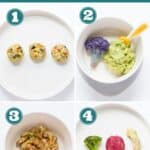


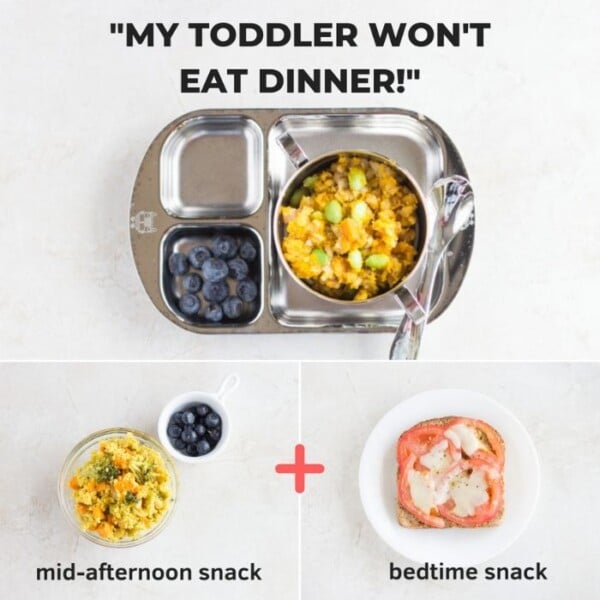
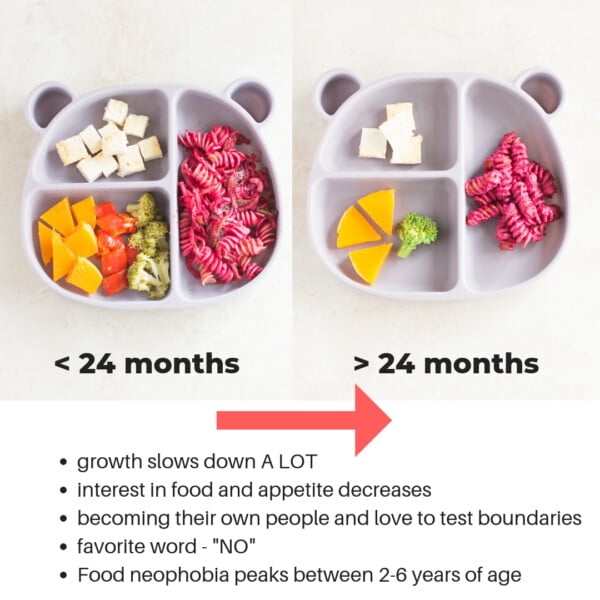









Thank you for this! Which food category would hummus fall into?
You’re welcome! Can count as both iron and high energy food!
Hello! Do you happen to have a recipe for your beef stroganoff? Thanks in advance!
Hi! The recipe is in my one pot meals ecookbook which you can find on my shop page if you are interested!
I just stumbled across your site and it was exactly what I needed! So much great advice and information! Thank you.
I’m SO glad you are here!